The use and occupancy patterns of a non-dwelling can be complex. This section highlights a number of scenarios that frequently occur and the consequent requirements for an EPC. These examples may change over time and are not a definitive list of the possible situations which may occur.
Offices blocks and mixed use buildings
Office space can be let floor by floor, a number of floors or part of a floor. If a building has a common heating system, then an EPC may be prepared for the whole building and used for any part when sold or rented out. Common areas are included in the calculation. Other separate dwellings within the block will each require their own domestic EPC.
Block with common heating system
If an office building has a common heating system, the seller or landlord should provide an EPC for the whole building (separate dwellings within the block will each require their own EPC). It is permissible to prepare an individual EPC for a part of a building if required. An EPC for a single unit or apartment may be based on an assessment of a similar representative unit or apartment in the same block.

- An EPC may be produced for a separate part if required. Communal areas are not included in the calculation.
- 1 EPC is required for each separate dwelling.
- 1 EPC for the remainder of the building. Can be used for any part of the building when sold or let. Communal areas are included in the calculation.
Block with independent heating system
It is permissible to provide EPCs for each of the individual parts, plus an EPC for the conditioned communal areas when selling or renting out the whole building or to provide one EPC for the whole building.
Each separate dwelling will require its own EPC. The energy calculation for dwellings must be produced using the standard assessment procedure or reduced data standard assessment procedure methodology. The energy assessor carrying out this work must be accredited to carry out an assessment for dwellings.
The non-dwelling part(s) of the building or building unit should be assessed using either simplified building energy model or dynamic simulation model and the energy assessor must be accredited to carry out assessments for non-dwellings. It is appropriate that when any communal areas (including those serving the residential space) are assessed, this is done using simplified building energy model or dynamic simulation model as the methodology used for dwellings, will only be appropriate for dwellings.
An EPC for a single unit within a building may be based on an assessment of a similar representative unit or apartment in the same block.

- 1 EPC for the whole building (excluding any dwellings), only if sold or rented out as a whole building. Communal areas would be included in EPC. EPC can subsequently be used for whole building only.
- 1 EPC is required for each separate dwelling.
- 1 EPC for each separate building unit when sold or rented out. Communal areas are not included in the calculation.
Shop with dwellings above
In the example below the residential dwelling space above the shop has separate access and is clearly designed to be used as a dwelling separate from the conduct of business in the shop, whether the two parts are sold or let together or separately. In this case the residential space should have its own EPC using the standard assessment procedure or reduced data standard assessment procedure methodology as appropriate.
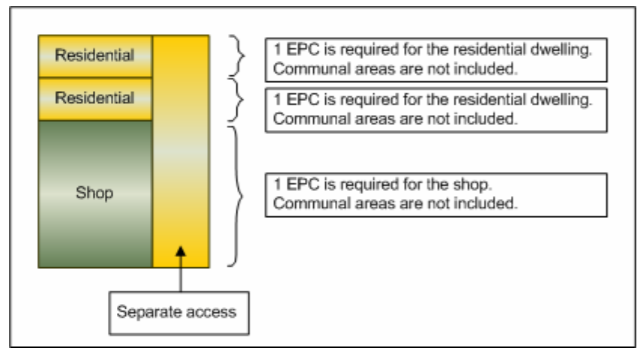
- 1 EPC is required for the residential dwelling. Communal areas are not included.
- 1 EPC is required for the shop. Communal areas are not included.
Shop with residential space above
In the example below, the residential space above the shop can only be accessed via the shop. In this case the upper part is not designed or altered for use as a separate dwelling and should, therefore, be considered and assessed with the shop as a single building, for which the simplified building energy model methodology will be more appropriate.
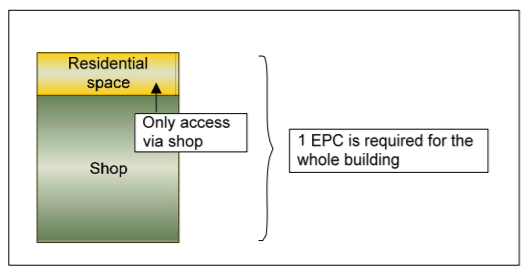
- 1 EPC is required for the whole building.
Commercial or industrial building with significant living accommodation
In the example below, the shop is formerly a room in a dwelling. If the building is subsequently sold or let and could be used as a dwelling it should be assessed as a dwelling using the standard assessment procedure or reduced data standard assessment procedure methodology as appropriate. This is where the living accommodation is a significant proportion (i.e. more than half) of the total area of the building.
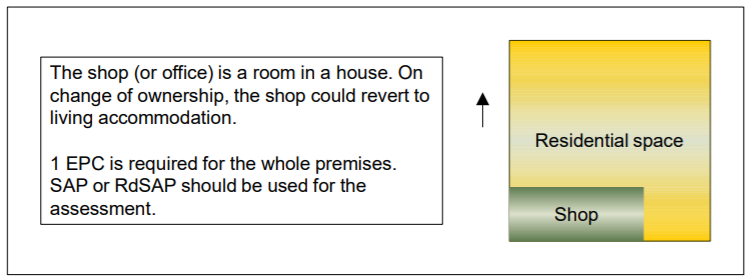
- The shop (or office) is a room in a house. On change of ownership, the shop could revert to living accommodation.
- 1 EPC is required for the whole premises. SAP or RdSAP should be used for the assessment.
Shopping centre, retail units and concourses
An EPC for a single unit may in all cases be based on an assessment of a similar representative unit in the same block).
Centre with common heating systems and conditioned communal space
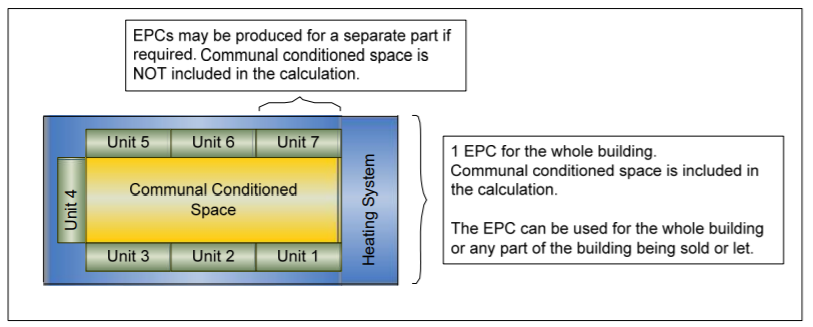
- EPCs may be produced for a separate part if required. Communal conditioned space is not included in the calculation.
- 1 EPC for the whole building. Communal conditioned space is included in the calculation.
- The EPC can be used for the whole building or any part of the building being sold or let.
If, unlike in the example above, a unit does not directly access the concourse or mall (i.e. it does not share conditioning) and it does not have its own heating or the ability to have its own heating, then it will not require an EPC as it will not be considered to be a building for the purposes of the regulations.
Centre with common heating systems and unconditioned communal space
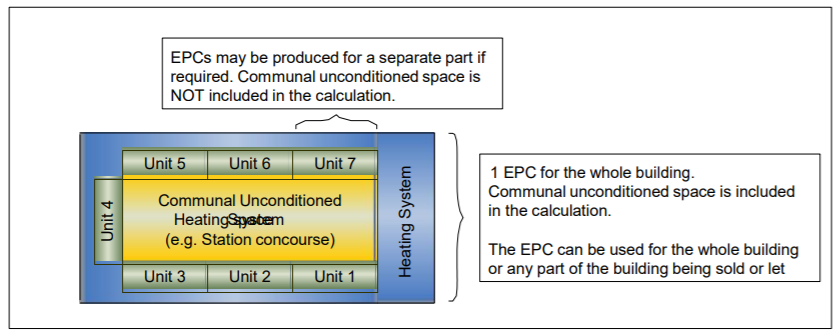
- EPCs may be produced for a separate part if required. Communal unconditioned space is not included in the calculation.
- 1 EPC for the whole building. Communal unconditioned space is included in the calculation.
- The EPC can be used for the whole building or any part of the building being sold or let.
Centre with independent heating systems
In examples below, it is permissible to provide EPCs for each of the individual units, plus an EPC for the conditioned communal areas when selling or renting out the whole building or provide one EPC for the whole building.
Centre with conditioned communal space

- 1 EPC for each unit when sold or let. Communal conditioned space would not be included in the calculation.
- 1 EPC for the whole building only if it is being sold or let as one building. Communal conditioned space would be included in the calculation.
Centre with unconditioned communal space

- 1 EPC for each unit when sold or let. Communal unconditioned space would not be included in the calculation.
- 1 EPC for the whole building only if it is being sold or let as one building. Communal unconditioned space would be included in the calculation.
Industrial units in blocks
Stand-alone buildings or building units (i.e. those which are entirely detached and not connected to another building or building unit) with a total useful floor are of less than 50m2, will not require an EPC.
Units with a common heating system
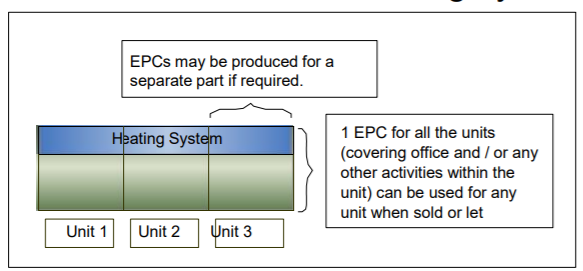
- EPCs may be produced for a separate part if required.
- 1 EPC for all the units (covering office and / or any other activities within the unit) can be used for any unit when sold or let.
Units with independent heating systems

- 1 EPC for each unit (covering office and / or any other activities within the unit) when sold or let.
- 1 EPC for all the units (covering office and / or any other activities with in the unit) only when all the units are sold or let as one entity.
It is permissible to provide EPCs for each of the individual parts, plus an EPC for the conditioned communal areas when selling or letting the whole building or provide one EPC for the whole building.
Units with a variety of heating systems and both conditioned and unconditioned space
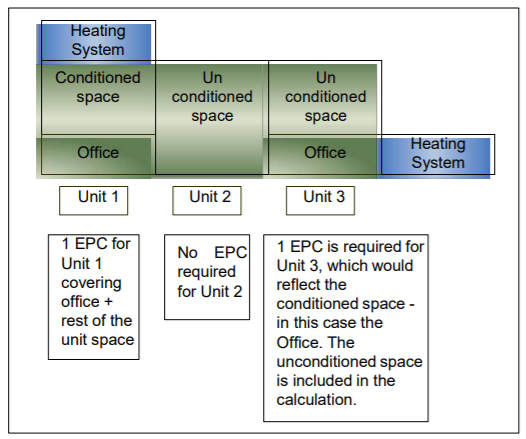
- Unit 1 (conditioned space and office): 1 EPC for unit 1 covering office + rest of the unit space.
- Unit 2 (unconditioned space): No EPC required for unit 2.
- Unit 3 (unconditioned space and office): 1 EPC is required for unit 3 which would reflect the conditioned space - in this case the office. The unconditioned space is included in the calculation.
It is permissible in this example to provide EPCs for each of the individual parts, plus an EPC for the conditioned communal areas when selling or letting the whole building or provide one EPC for the whole building.
Mike Gordon
Comments